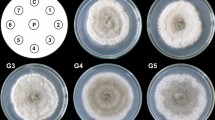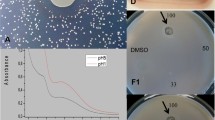Abstract
The cultural characteristics of the fungusCladosporium phlei were assessed in order to develop an improved method for the production of the fungal pigment, phleichrome, which is an intermediate in the production of a photodynamic therapeutic agent. The growth ofC. phlei, as measured by the hyphal growth rate and increase in biomass, varies significantly depending on the culture media utilized (V8 juice-based medium proved optimal for both growth rate and biomass increase). How-ever, even on a V8 juice plate, the growth ofC. phlei occurred slowly and in a limited fashion, in that the colony covered only 75% of the agar surface after more than 4 weeks of cultivation at 20°C. Supplementations of glucose, fructose, galactose, and sucrose increased both hyphal expansion and mass production, whereas supplementations of other carbon sources, including glycerol and sorbitol, exerted no detectable effects. The effect of inorganic nitrogen supplementation was negligible, whereas organic nitrogen evidenced significant effects, with enhanced growth with malt extract and growth inhibition with yeast extract and tryptone. Sporulation was enhanced under conditions of continuous light, and a minimum of 103 spores per mL of liquid media was found to be necessary for the optimal mass increase. A simple extraction procedure was established in order to isolate the deep red pigment which was subsequently identified as phleichrome via NMR analysis. WhenC. phlei was cultured on V8 medium containing 5% glucose and 2% malt extract, the quantity of mycelial mass was estimated as 20.6 g (dry weight) per liter of culture. The expected phleichrome yields from the mycelia and culture filtrates were estimated to be 43 and 2 mg/L, repectively.
Similar content being viewed by others
References
Olivo, M. and W. Chin (2006) Perylenequinones in photodynamic therapy: cellular versus vascular response.J. Environ. Pathol. Toxicol. Oncol. 25: 223–237
Diwu, Z. J. and J. W. Lown (1995) Photosensitization with anticancer agents 20-EPR studies on the photodynamic action of phleichrome: formation of semiquinone radical and activated oxygen species on illumination with visible light.Free Radic. Biol. Med. 18: 357–363.
Diwu, Z. J. (1995) Novel therapeutic and diagnostic applications of hypocrellins and hypericins.Photochem. Photobiol. 61: 529–539.
Lee, H. Y., Z. X. Zhou, S. Chen, M. H. Zhang, and T. Shen (2006) New long-wavelength ethanolamino-substituted hypocrellin: photodynamic activity and toxicity to MGC803 cancer cell.Dyes Pigments 68: 1–10.
Wu, T., S. J. Xu, J. Q. Shen, A. M. Song, S. Chen, M. H. Zhang, and T. Shen (2000) New potential photodynamic therapeutic anti-cancer agents: synthesis and characterization of demethoxy amino-substituted hypocrellins.Anticancer Drug Des. 15: 287–293.
Wu, T., J. Shen, A. Song, S. Chen, M. Zhang, and T. Shen (2000) Photodynamic action of amino substituted hypocrellins: EPR studies on the photogenerations of active oxygen and free radical species.J. Photochem. Photobiol. B 57: 14–21.
Zhang, J., E.-H. Cao, J.-F. Li, T.-C. Zhang, and W.-J. Ma (1998) Photodynamic effects of hypocrellin A on three human malignant cell lines by inducing apoptotic cell death.J. Photochem. Photobiol. B 43: 106–111.
Fehr, M. J., S. L. Carpenter, Y. Wannemuehler. and J. W. Petrich (1995) Roles of oxygen and photoinduced acidification in the light-dependent antiviral activity of hypocrellin A.Biochemistry 34: 15845–15848.
Kraus, G. A., W. Zhang, M. J. Fehr, J. W. Petrich, Y. Wannemuehler, and S. Carpenter (1996) Research at the interface between chemistry and virology: Development of a molecular flashlight.Chem. Rev. 96: 523–536.
Reynolds, T. (1997) Photodynamic therapy expands its horizons.J. Natl. Cancer Inst. 89: 112–114.
Hudson, J. B., V. Imperial, R. P. Haugland, and Z. Diwu (1997) Antiviral activities of photoactive perylenequinones.Photochem. Photobiol. 65: 352–354.
Diwu, Z. J., C. Zhang, and J. W. Lown (1992) Photosensitization with anticancer agents 13. The production of singlet oxygen by halogenated and metal-ion-chelated perylenequinones.J. Photochem. Photobiol. A 66: 99–112.
He, Y. Y., J. Y. An, W. Zou, and L. J. Jiang (1998) Photoreactions of hypocrellin B with thiol compounds.J. Photochem. Photobiol. B 44: 45–52.
He, Y. Y., J. Y. An, and L. J. Jiang (1999) Glycoconjugated hypocrellin: synthesis of [(β-D-glucosyl)ethylthiyl] hypocrellins and photosensitized generation of singlet oxygen.Biochim. Biophys. Acta 1472: 232–239.
Lee, H. Y., S. Chen, M. H. Zhang, and T. Shen (2003) Studies on the synthesis of two hydrophilic hypocrellin derivatives with enhanced absorption in the red spectral region and on their photogeneration of O2 and O2(1Δg).J. Photochem. Photobiol. B 71: 43–50.
Miller, G. G., K. Brown, A. M. Ballangrud, O. Barajas, Z. Xiao, J. Tulip, J. W. Lown, J. M. Leithoff, M. J. Allalunis-Turner, R. D. Mehta, and R. B. Moore (1997) Preclinical assessment of hypocrellin B and hypocrellin B derivatives as sensitizers for photodynamic therapy of cancer: progress update.Photochem. Photobiol. 65: 714–722.
Hauser, F. M., D. Sengupta, and S. A. Corlett (1994) Optically active total synthesis of calphostin D.J. Org. Chem. 59: 1967–1969.
Shimanuki, T. (1987) Studies on the mechanisms of the infection of timothy with purple spot disease caused byCladosporium phlei.Res. Bull. Hokkaido Natl. Agric. Exp. Stn. 148: 1–56.
Yoshihara, T., T. Shimanuki, T. Araki, and S. Sakamura (1975) Phleichrome; A new phytotoxic compound produced byCladosporium phlei.Arg. Biol. Chem. 39: 1683–1684.
Choi, E. S., H. J. Chung, M. J. Kim, S. M. Park, B. J. Cha, M. S. Yang, and D. H. Kim (2005) Characterization of the ERK homologue CpMK2 from the chestnut blight fungusCryphonectria parasitica.Microbiology 151: 1349–1358.
Puhalla, J. E. and S. L. Anagnostakis (1971) Genetics and nutritional requirements ofEndothia parasitica.Phytopathology 61: 169–173.
Carlsen, M. and J. Nielsen (2001) Influence of carbon source on alpha-amylase production byAspergillus oryzae.Appl. Microbiol. Biotechnol. 57: 346–349.
Ichinomiya, M., E. Yamada, S. Yamashita, A. Ohta, and H. Horiuchi (2005) Class I and class II chitin synthases are involved in septum formation in the filamentous fungusAspergillus nidulans.Eukaryot. Cell 4: 1125–1136.
Arnone, A., L. Camarda, G. Nasini, and L. Merlini (1985) Secondary mould metabolites. Part 13. Fungal perylenequinones: phleichrome, isophleichrome and their endoperoxides.J. Chem. Soc. Perkin Trans. 1: 1387–1392.
Seto, Y., Y. Kogami, T. Shimanuki, K. Takahashi, H. Matsuura, and T. Hoshihara (2005) Production of phleichrome byCladosporium phlei as stimulated by diketopiperadines ofEpichloe typhina.Biosci. Biotechnol. Biochem. 69: 1515–1519.
Gupta, K., P. K. Mishra, and P. Srivastava (2007) A correlative evaluation of morphology and rheology ofAspergillus terreus during lovastatin fermentation.Biotechnol. Bioprocess Eng. 12: 140–146.
Jang, M. Y., W. Y. Ryu, and M. H. Cho (2006) Enhanced production of laccase fromTrametes sp. by combination of various inducers.Biotechnol. Bioprocess Eng. 11: 96–99.
Kim, S. J., M. J. Kim, and M. Shoda (2006) Decolorization of dye and molasses by continuous and semicontinuous jar-fermentor cultures ofGeotrichum candidum Dec 1.Biotechnol. Bioprocess Eng. 11: 306–312.
Author information
Authors and Affiliations
Corresponding author
Additional information
There was an equal contribution of the reported research by the first two authors.
Rights and permissions
About this article
Cite this article
Lee, JK., Kim, BT., Kim, JA. et al. Cultural characteristics and extraction of the fungal pigment phleichrome from the phytopathogenic fungusCladosporium phlei . Biotechnol. Bioprocess Eng. 12, 508–515 (2007). https://doi.org/10.1007/BF02931348
Received:
Accepted:
Issue Date:
DOI: https://doi.org/10.1007/BF02931348




